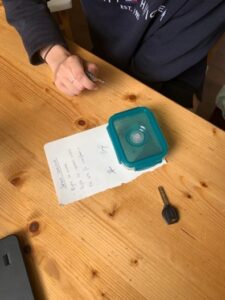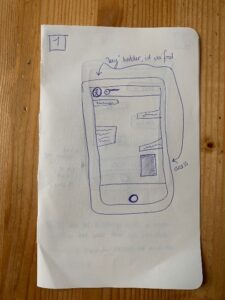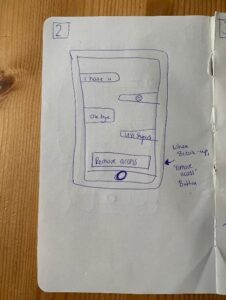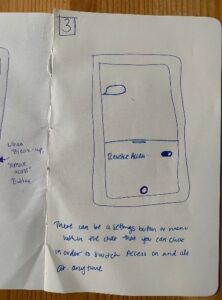Premise
Memes have been a big part of online ecosystem for years and integration with NFT technology might convert them into a digital historic archive and give their creators monetization opportunities.
Synopsis
Semester “C” weeks I will never forget. On the 24th of February, 2022 Vladimir Putin had turned the worst page in modern Russian history. Since then, we have been observing the most horrifying, ugly, and powerful cases of propaganda and fake news on both sides of the conflict. Being half-Russian/half-Ukrainian and having cousins in both countries, I see enormous polarization in opinions to the extent that people are unable to speak or listen.
Although there’s a striking phenomenon – one thing is still considered by both sides more or less equally – humor that comes in the form of MEMES. Close ethnically, Russians and Ukrainians still find very similar jokes funny, re-post them and react with mitigation of hostility.


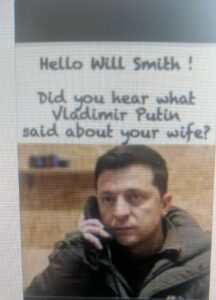

That made me think that MEMES could be a great mirror of society, modern-day chronicles, which tend to disappear quickly. The idea is to find ways to save such newsreels, not only in connection to this ugly war but generally as a chronicle of the history, and give the authors ways to monetize them. An excellent way for it is NFT technology, and the reasons why are stated in the next section.
Substantiation
When it comes to Memes, the topic is familiar to an average internet user and perfectly fits into a concept of “shared economy,” where digital content is created, shared, re-posted, and consumed without such restrictions on copyrights and ownership, NFT technology provides significant advancement toward claiming ownership for both, tangible and intangible assets, in a more transparent, secure, and concrete form, thanks to being derived from blockchain technology.
Smart contracts for NFTs can ensure that money and assets change securely (Dowling, M., 2021) and that parties are clear about the content of agreements, reducing the need for middle-agents (Morkunas, V., Paschen, J., Boon E , 2019), so NFTs as a technology simplify the process of converting assets to tokens to facilitate ease of movement within the legal ecosystem.
There are some proven assumptions (Angelis. J., and Da Silva. E., 2019) that different NFT standards have a great chance to replace processes human-centered guarantors of authenticity via lawyers and escrow agents in industries such as property and vehicle sales.
Provable Scarcity:
Either real worlds objects or virtual(digital) objects derive value and capitalization from their scarcity(Fairfield.J.,2021). Each NFT asset can be tracked on the blockchain along with its unique details. It is possible to parse the chain data for all assets in existence and group assets by traits. So, users can independently verify collectible rarities and quantities, 100% uniqueness, and lack of duplicates now and in the future.
And unlike cryptocurrencies (such as Bitcoins or Ethers), which are “fungible” and “interchangeable”, “non-fungibility” makes an NFT a unique and scarce asset.
Freely accessible by major players within the industry:
NFT marketplaces and crypto markets, where NFTs are being traded, are pretty transparent about their items and collections and freely provide APIs to work with. As an example – the largest NFT marketplace OpenSea API:
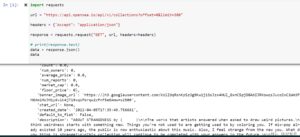
A gap in the Market:
There’s an extensive number of channels where NFTs of all kinds are being traded. OpenSea.io (Etherium, Polygon, now Solana), Rarible(Etherium, Flow, Tezos), Nifty Gateway(Etherium), SolanArt(Solana), Axie(Robin), Binance NFT MarketPlace(BSN), Decentraland(Etherium, MANA), NBA Top Shot (Flow), SportsCoin(Flow) and other platforms are either generally NFT or specialize in rare/sports/in-games/music items. The great news is that none of them specializes in or has a dedicated NFT Memes section.
Immutable Ownership:
NFT items have a unique immutable reference written to the Blockchain. Once ownership is transferred, it’s recorded within the smart contract and can’t be edited; only the next performed transactions could be added with that NFT.
Possible limitations and barriers to entry: miscellaneous NFT standards.
When it comes to technical aspects of NFT, different industry technical standards should be taken into consideration to influence cost formation in NFT marketplaces and NFT minting.
NFT originated from the Ethereum blockchain and started using a non-fungible token standard ERC-721 in 2018 (Ethereum official documentation, 2021).
ERC-721 is widely used in many original NFTs with high capitalization and implements an API for single tokens within Smart Contract.
Later ERC-1155(2019) standard is rather used for collections of NFTs or as a combination of ERC-721 and ERC-20(a standard for fungible tokens). ERC-1155 works for all types of assets: fungible and non-fungible.
Like many pioneering technologies, ERC standards are not just widely used but with the highest transaction and gas fees.
Early adopters of the technology, such as Binance Smart Chain(BEP-721 and BEP-1155), Tezos (TZIP-12), Flow(fast, low-cost transactions, ideal for dApps environment, like NFT marketplaces and crypto games.), TRON(TRC-721 and TRC-1155), offer their own standards extending NFT applicability to many different platforms and, due to later advanced development, offer significantly lower transactional and gas fees.
So, high gas and transaction fees will be the main challenge and unpleasant surprise for an unprepared creator of a meme.
Monetization opportunities for content (Memes) creators are undoubted, see the graph below (Buchholz, K., 2021)
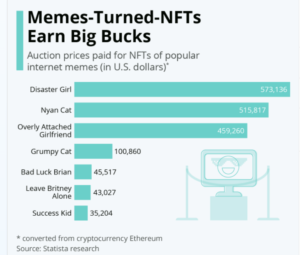
Prototypes & Experiments
Iteration #1
I have started my project with an open interview to find out if there would be some interest in such service, which brought some stunning insights. Not many interviewed understand:
1) why NFT technology could/should be used
2) what NFT is
3) if NFT is anything more than just badly overprized .jpeg images
Solution #1
The solution to the problem is either educating potencial Memes creators or “hiding” the implementation part deep into the solution, making it as simple and user-friendly as possible.
An application with “hidden” implementation of the parts, where users should be choosing cryptotokens, marketplaces, platforms for their memes and the process of converting them into an NFT itself, has been chosen as a solution.
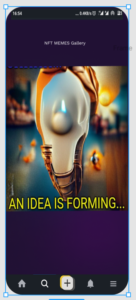
Iteration #2
The simplest prototypes was tested on potencial users with options to convert a meme into an NFT with the easiest possible way.
To navigate withing the Gallery the users are able to see “Latest” added items, “Channels” to communicate in Telegramm chats, form “Groups” and “Filter” items in the gallery.
An NFT could be converted from a picture or a photo and after to be [$] placed into external marketplaces for monetisation and [#] tagged to be shared in social media.
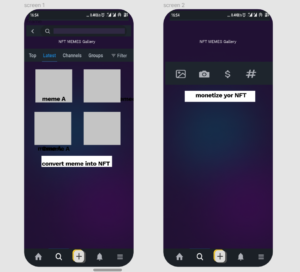
Solution #2
The initial idea of a “gallery for novice users” turned into a practical and functional “converter” from traditional formats into NFT-format with granting a ownership priviliges.
(as a simple example, given by an interviewee – “Instagram” has 3 buttons – I use it, “FB” is too cumbersome, stopped using it.)
The feedbacks were favourable as the app dosn’t overwhelm NFT-unsavvy user with unnecessary functionality and information.
The main challenge for the next part is to:
1) continue keeping the app as simple as possible with “hidden” from th euser technical details
2) come up with the most resource and cost-efficient way of publishing NFT memes
3) to find the best revenue model and other means of the monetisation for the Converter.
Iteration #3
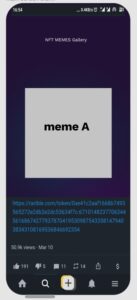
At this stage of the prototype the user receives the NFT “ownership”(the link on the screen), can see the platform where the NFT is traded, [$]the wallet, observe views/likes/comments from other platforms about his/her creation.
Solution #3
The main objective – to keep the solution as simple as possible for unsavvy NFT user is completed.
After a long consideration the best revenue model turned to be a comission from the first sale of the NFT(on top of the marketplace comission), if the sale happens. Gas and Transaction costs the Gallery/Converter has to cover itself and should not bother the authors of the NFT Memes.
Conclusion:
https://www.figma.com/proto/y415bimKGqXZsG5DsUI5MF/NFT?page-id=0%3A1&node-id=7%3A117&viewport=241%2C48%2C0.23&scaling=scale-down&starting-point-node-id=7%3A43
The original idea of an NFT Memes Gallery, which main purpose would be keeping records of history in such novel and witty way as Memes, together with stimulating creativity by paying the authors (with instruments, provided by emerging NFT technology), evolved into a user-friendly Memes-to-NFT_Memes Converter.
User-Friendliness can’t be a trade-off. This trade-off became apparent during the iterations of User Research.
Reference List
Fairfield.J.(2021), “Tokenized: The Law of Non-Fungible Tokens and Unique Digital Property.” Indiana Law Journal, Forthcoming,
Available at SSRN: https://ssrn.com/abstract=3821102
Angelis. J., and Da Silva. E., (2019)”Blockchain adoption: A value driver perspective”, Science Direct
https://www.sciencedirect.com/science/article/pii/S0007681318302088
Dowling, M. (2021). “Is non-fungible token pricing driven by cryptocurrencies?” Finance Research Letters.
Advance online publication. https://doi.org/10.1016/j.frl.2021.102097
Business Horizons, 62 (3) (2019), pp. 295-306, 10.1016/j.bushor.2019.01.009
Zhang, Y and Cheng, H. Kenneth, (2022) “How to Sell your Crypto Art? Evidence from Non-fungible Token Art Drops” https://ssrn.com/abstract=4047023Mazur, M., (2021) “Non-Fungible Tokens (NFT). The Analysis of Risk and Return” https://ssrn.com/abstract=3953535 or http://dx.doi.org/10.2139/ssrn.3953535Ethereum official documentation. ERC -721 Non-fungible token standard.
https://ethereum.org/en/developers/docs/standards/tokens/erc-721/
https://ethereum.org/en/developers/docs/standards/tokens/erc-1155/Sportsicon official documentation https://docs.sportsicon.com/whitepaper/overview-of-sportsiconSoRare platform official documentation (2022)
https://help.sorare.com/hc/en-us/categories/360003699737-Getting-started-
Buchholz, K. (2021) “Memes-Turned-NFTs Earn Big Bucks” https://www.statista.com/chart/24814/meme-nft-auction-prices/?utm_source=Statista+Newsletters&utm_campaign=ef0d341d89-All_InfographTicker_daily_COM_PM_KW17_2021_We_COPY&utm_medium=email&utm_term=0_662f7ed75e-ef0d341d89-315801217
Read more "NFT Memes Gallery"

